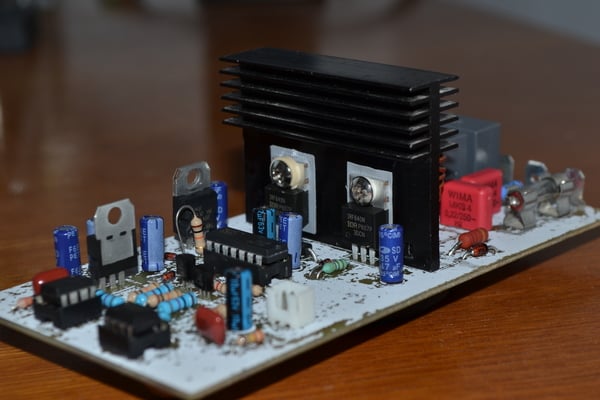
Class D amplifiers operate at frequencies well beyond the audio band, bringing further challenges in reliability and immunity to noise, both external interference and self-noise.īefore outputting a signal, the switching pulses must be filtered to minimise or eliminate the effects of the unwanted interference and high-frequency noise generated by the switching amplifier. Switching transistors use no power when fully off and when fully on present the least resistance and thus the lowest possible power consumption. They use either pulse width modulation (PWM) or pulse density modulation (PDM) techniques.
#Diy class d amplifier kit full#
Though it has to be said that neither a switching amplifier nor a switching power supply are especially suited to amplifying audio.Ī switching amplifier is, as its name implies, one in which the transistors are operated either full on or full off, the pulses modulated by the audio signal. After all, pairing a class D amplifier with a linear power supply as in a traditional amplifier outweighs much of the class D advantage. Class D is an analogue switching typology, and class D amplifiers are often paired with a switching power supply. The primary, and really the only advantage of a class D amplifier over and above a good linear design is efficiency and compactness.

NCore amps are largely based on the same principles but also implement a control loop adding 20dB of gain across the full audio range without sacrificing stability. In short, Hypex Class D amplifiers are is ultra-linear, with noise and distortion levels that are next to non-existent and should certainly be inaudible to the human ear. And new gate drive circuitry improves open-loop distortion at moderate signal levels while significantly reducing idle losses. Improved comparator circuitry, where the PWM signal is created by comparing the input signal to the signal of a high-frequency triangular wave generator, insures that actual behaviour matches the theoretical model as closely as possible. A mathematically exact understanding of self-oscillation allows optimisation of large-signal performance.

The current crop of UCD amplifiers bare little resemblance to the original 2001 circuit. Many highly respected brands – Marantz and NAD to name just two – are now using Hypex technology in their flagship products, with many more following suit.

Via, Hypex directly supplies products to the DIY market, while Hypex Electronics also supply products to OEM manufacturers. Today, Hypex is primarily split into two divisions. Further to his joining Hypex, Putzeys also founded Mola-Mola – a high-end brand for which he designed a complete range of five-figure amplification and source electronics. Putzeys invented the technology working in the Philips lab in Leuven (Belgium) producing an initial 25W module intended for use in a television, and later developing modules with more power and a refined design. Unlike the implementations of class D switching typology that came before, UCD modules have a flat frequency response irrespective of load impedance, nearly frequency-independent distortion behaviour and very low radiated and conducted EMI. Bruno developped the Universal Class D (UCD) technology during his work at Philips and was hired in 2005 by Hypex to lead its R&D and engineering, after the company agreed a licensing deal with Philips for the UCD technology in 2003.
#Diy class d amplifier kit pro#
Founded in 1996, Hypex supplied plate amplifiers to the pro audio market and later to hi-fi manufacturers, first with a line of plate amps developed for subwoofers and later multi-channel units and active crossovers for studio use. Perhaps the most notable of these designers in recent times is Bruno Putzeys of Hypex Electronics. Engineers have more recently made considerable efforts to optimise the technology to a point where it can equal, or even surpass, a traditional linear class A or class A/B design. Not that audiophile acceptance would ever stop me using a product, but the abysmal measurements demonstrated by many first-generation class D products certainly did. It’s only really been in the last 15 years or so that class D, as a technology, has developed to the point where it is generally accepted within audiophile circles. But besides some active speakers and a few pro audio models where efficiency and power output takes precedence over fidelity, I’ve yet to hear a true hi-fi class D amplifier. I’ve been intrigued by class D amplification for many years.


 0 kommentar(er)
0 kommentar(er)
